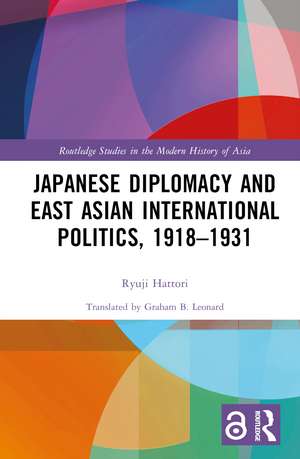Japanese Diplomacy and East Asian International Politics, 1918–1931: Routledge Studies in the Modern History of Asia
Autor Ryuji Hattori Traducere de Graham B. Leonarden Limba Engleză Hardback – 12 ian 2024
The Open Access version of this book, available at www.taylorfrancis.com, has been made available under a Creative Commons CC-BY-NC-ND 4.0 license.
Din seria Routledge Studies in the Modern History of Asia
-
 Preț: 311.33 lei
Preț: 311.33 lei -
 Preț: 311.41 lei
Preț: 311.41 lei -
 Preț: 317.76 lei
Preț: 317.76 lei -
 Preț: 310.95 lei
Preț: 310.95 lei -
 Preț: 311.91 lei
Preț: 311.91 lei - 9%
 Preț: 901.50 lei
Preț: 901.50 lei -
 Preț: 379.30 lei
Preț: 379.30 lei - 25%
 Preț: 711.72 lei
Preț: 711.72 lei - 18%
 Preț: 1278.70 lei
Preț: 1278.70 lei - 18%
 Preț: 948.84 lei
Preț: 948.84 lei - 18%
 Preț: 1055.21 lei
Preț: 1055.21 lei - 18%
 Preț: 1331.76 lei
Preț: 1331.76 lei - 18%
 Preț: 1003.30 lei
Preț: 1003.30 lei - 18%
 Preț: 1060.87 lei
Preț: 1060.87 lei -
 Preț: 424.87 lei
Preț: 424.87 lei -
 Preț: 485.94 lei
Preț: 485.94 lei - 18%
 Preț: 1004.86 lei
Preț: 1004.86 lei - 18%
 Preț: 1326.99 lei
Preț: 1326.99 lei - 18%
 Preț: 1060.87 lei
Preț: 1060.87 lei - 18%
 Preț: 1058.65 lei
Preț: 1058.65 lei -
 Preț: 441.80 lei
Preț: 441.80 lei - 28%
 Preț: 820.03 lei
Preț: 820.03 lei - 18%
 Preț: 1059.84 lei
Preț: 1059.84 lei - 28%
 Preț: 821.79 lei
Preț: 821.79 lei - 18%
 Preț: 1063.65 lei
Preț: 1063.65 lei - 18%
 Preț: 1059.84 lei
Preț: 1059.84 lei - 49%
 Preț: 218.36 lei
Preț: 218.36 lei - 18%
 Preț: 704.83 lei
Preț: 704.83 lei - 18%
 Preț: 1012.10 lei
Preț: 1012.10 lei - 25%
 Preț: 826.86 lei
Preț: 826.86 lei - 18%
 Preț: 1002.63 lei
Preț: 1002.63 lei - 15%
 Preț: 699.14 lei
Preț: 699.14 lei - 18%
 Preț: 1114.30 lei
Preț: 1114.30 lei - 27%
 Preț: 995.07 lei
Preț: 995.07 lei - 26%
 Preț: 765.01 lei
Preț: 765.01 lei - 18%
 Preț: 1059.84 lei
Preț: 1059.84 lei - 26%
 Preț: 821.94 lei
Preț: 821.94 lei - 18%
 Preț: 1056.00 lei
Preț: 1056.00 lei - 18%
 Preț: 1006.07 lei
Preț: 1006.07 lei -
 Preț: 488.71 lei
Preț: 488.71 lei - 18%
 Preț: 999.46 lei
Preț: 999.46 lei - 18%
 Preț: 1051.55 lei
Preț: 1051.55 lei - 18%
 Preț: 1065.78 lei
Preț: 1065.78 lei - 25%
 Preț: 769.10 lei
Preț: 769.10 lei - 18%
 Preț: 1054.43 lei
Preț: 1054.43 lei - 26%
 Preț: 765.01 lei
Preț: 765.01 lei - 18%
 Preț: 1009.21 lei
Preț: 1009.21 lei
Preț: 1011.64 lei
Preț vechi: 1233.71 lei
-18% Nou
Puncte Express: 1517
Preț estimativ în valută:
193.57€ • 202.68$ • 160.56£
193.57€ • 202.68$ • 160.56£
Carte tipărită la comandă
Livrare economică 10-24 aprilie
Preluare comenzi: 021 569.72.76
Specificații
ISBN-13: 9781032675930
ISBN-10: 1032675934
Pagini: 336
Ilustrații: 7 Tables, black and white; 1 Halftones, black and white; 1 Illustrations, black and white
Dimensiuni: 156 x 234 x 21 mm
Greutate: 0.78 kg
Ediția:1
Editura: Taylor & Francis
Colecția Routledge
Seria Routledge Studies in the Modern History of Asia
Locul publicării:Oxford, United Kingdom
ISBN-10: 1032675934
Pagini: 336
Ilustrații: 7 Tables, black and white; 1 Halftones, black and white; 1 Illustrations, black and white
Dimensiuni: 156 x 234 x 21 mm
Greutate: 0.78 kg
Ediția:1
Editura: Taylor & Francis
Colecția Routledge
Seria Routledge Studies in the Modern History of Asia
Locul publicării:Oxford, United Kingdom
Public țintă
AcademicNotă biografică
Ryuji Hattori is a Professor in the Faculty of Policy Studies at Chuo University, Japan and has a Bachelor’s from Kyoto University, an MA from Johns Hopkins University, and a Ph.D. from Kobe University.
Graham B. Leonard is an Independent Translator and Researcher based in Seattle, Washington, USA.
Graham B. Leonard is an Independent Translator and Researcher based in Seattle, Washington, USA.
Cuprins
List of illustrations
Preface
Usage Notes
Name Equivalencies
Acronyms
Introduction: Japanese Diplomacy and Interwar East Asia’s “Four Waves of International Change”
1 The First Wave of International Change and Hara Diplomacy: September 1918 to November 1921 – The Hara Government
2 The Creation of the Washington System and the Second Wave of International Change: November 1921 to January 1924 – The Takahashi, Kato- Tomosaburo - , and Yamamoto Governments
3 New Movements in China and the Soviet Union and the First Era of Shidehara Diplomacy: January 1924 to April 1927 – The Kiyoura, Kato- Takaaki, and Wakatsuki Governments
4 The Establishment of the Nationalist Government and Tanaka Diplomacy: April 1927 to July 1929 – The Tanaka Government
5 The Second Era of Shidehara Diplomacy and the Third Wave of International Change: July 1929 to December 1931 – The Hamaguchi and Wakatsuki Governments
Conclusion: International Changes and Policy Trends
Afterword
Index
Preface
Usage Notes
Name Equivalencies
Acronyms
Introduction: Japanese Diplomacy and Interwar East Asia’s “Four Waves of International Change”
1 The First Wave of International Change and Hara Diplomacy: September 1918 to November 1921 – The Hara Government
2 The Creation of the Washington System and the Second Wave of International Change: November 1921 to January 1924 – The Takahashi, Kato- Tomosaburo - , and Yamamoto Governments
3 New Movements in China and the Soviet Union and the First Era of Shidehara Diplomacy: January 1924 to April 1927 – The Kiyoura, Kato- Takaaki, and Wakatsuki Governments
4 The Establishment of the Nationalist Government and Tanaka Diplomacy: April 1927 to July 1929 – The Tanaka Government
5 The Second Era of Shidehara Diplomacy and the Third Wave of International Change: July 1929 to December 1931 – The Hamaguchi and Wakatsuki Governments
Conclusion: International Changes and Policy Trends
Afterword
Index
Descriere
This book provides an overall picture of East Asian international politics during the early interwar period and examines the various foreign policy trends of the major powers involved.
